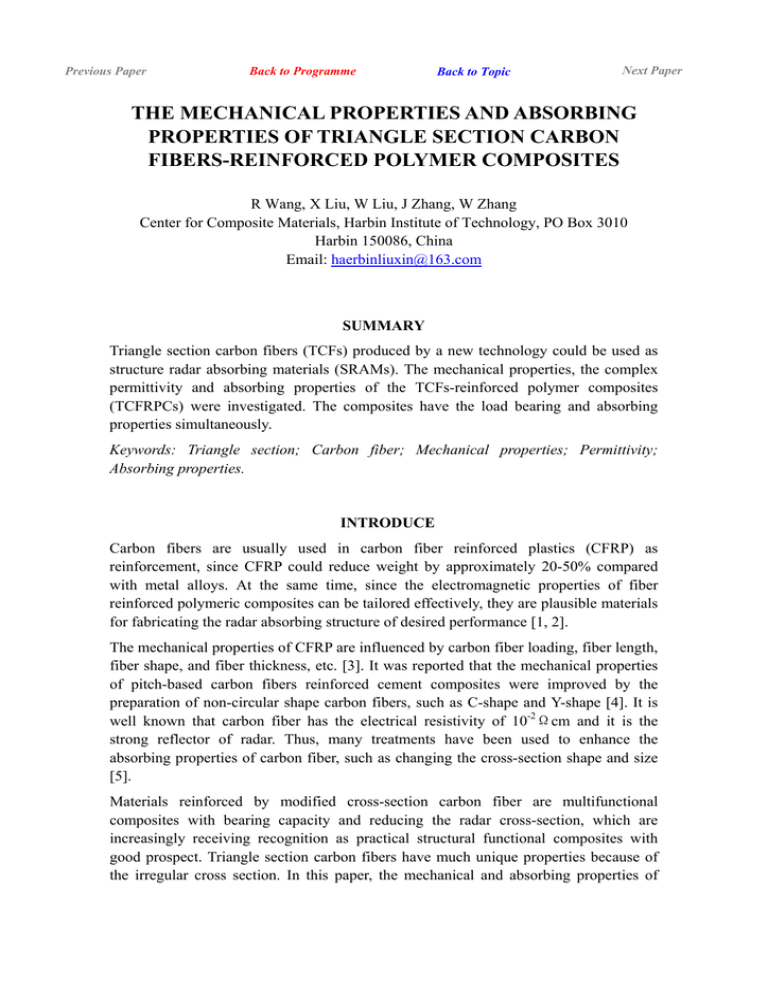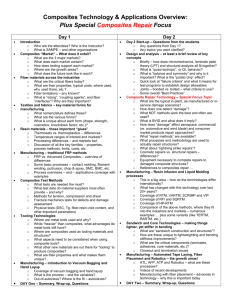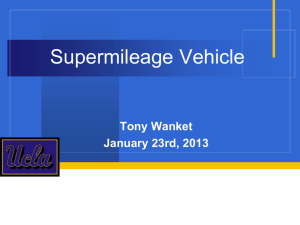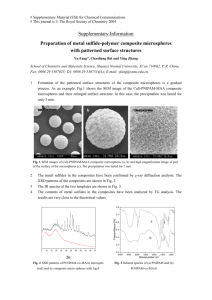THE MECHANICAL PROPERTIES AND ABSORBING PROPERTIES OF TRIANGLE SECTION CARBON
advertisement

Previous Paper Back to Programme Back to Topic Next Paper THE MECHANICAL PROPERTIES AND ABSORBING PROPERTIES OF TRIANGLE SECTION CARBON FIBERS-REINFORCED POLYMER COMPOSITES R Wang, X Liu, W Liu, J Zhang, W Zhang Center for Composite Materials, Harbin Institute of Technology, PO Box 3010 Harbin 150086, China Email: haerbinliuxin@163.com SUMMARY Triangle section carbon fibers (TCFs) produced by a new technology could be used as structure radar absorbing materials (SRAMs). The mechanical properties, the complex permittivity and absorbing properties of the TCFs-reinforced polymer composites (TCFRPCs) were investigated. The composites have the load bearing and absorbing properties simultaneously. Keywords: Triangle section; Carbon fiber; Mechanical properties; Permittivity; Absorbing properties. INTRODUCE Carbon fibers are usually used in carbon fiber reinforced plastics (CFRP) as reinforcement, since CFRP could reduce weight by approximately 20-50% compared with metal alloys. At the same time, since the electromagnetic properties of fiber reinforced polymeric composites can be tailored effectively, they are plausible materials for fabricating the radar absorbing structure of desired performance [1, 2]. The mechanical properties of CFRP are influenced by carbon fiber loading, fiber length, fiber shape, and fiber thickness, etc. [3]. It was reported that the mechanical properties of pitch-based carbon fibers reinforced cement composites were improved by the preparation of non-circular shape carbon fibers, such as C-shape and Y-shape [4]. It is well known that carbon fiber has the electrical resistivity of 10-2Ωcm and it is the strong reflector of radar. Thus, many treatments have been used to enhance the absorbing properties of carbon fiber, such as changing the cross-section shape and size [5]. Materials reinforced by modified cross-section carbon fiber are multifunctional composites with bearing capacity and reducing the radar cross-section, which are increasingly receiving recognition as practical structural functional composites with good prospect. Triangle section carbon fibers have much unique properties because of the irregular cross section. In this paper, the mechanical and absorbing properties of triangle section carbon fibers-reinforced polymer composites were evaluated. EXPERIMENTS Scanning Electron Microscopy (SEM) Longitudinal surface morphology of TCF was characterized using scanning electron microscope (Philips XL30 ESEM-FEG), the working voltage was set to 15.0kV in experiment, and the magnification was set for 10k. As shown in Fig.1, the cross-section shape of TCF is similar triangular and the areas is 39.2µm2. Fig.1. SEM photograph of triangle section carbon fibers Tension test Unidirectional carbon fiber composites were made using capping machine in Center for Composite Materials and Structure, Harbin Institute of Technology, China. The resin mass fraction of specimens was about 40%. The longitudinal tensile tests and vertical strain were taken by Zwick/Roell universal testing machine and YE2539 strain gauge respectively, as shown in Fig.2. Fig.2 Devices for unidirectional CFRP tensile test Electromagnetic and absorbing characterization The imaginary part (ε") of the complex permittivity and loss tangent (tan δe) of triangle section carbon fibers-reinforced polymer composites were measured by E8363B vector network analyzer (10MHz~40GHz). The dimensions of specimens were 22.86 mm (length)×10.16 mm (width)×2 mm (thickness) and 15.8 mm (length)×7.9 mm (width)×2 mm (thickness) in X-band frequency range (8-12GHz) and Ku-band frequency range (13-18GHz), respectively. The reflectivity of TCFRPCs with the size of 180 mm (length)×180 mm (width)×2 mm (thickness) with a metallic base plate was also tested in 207 Research Institute Aerospace Corporation of China. RESULTS AND DISCUSSION Predicting the Modulus and Poisson’s Ratio According to the SEM, the side length of TCF measured is 9.43μm. The unit model of composites was designed as shown in Fig.3. By homogenization theory, the modulus and Poisson’s ratio of triangle section carbon fibers-reinforced polymer composites were predicted. According to the results, the modules and the Poisson’s ratio were about 145.30 GPa and 0.28, respectively. Fig.3 The unit models of TCFRPCs Tensile Experiments According to ASTM D3039, the longitudinal tensile tests of triangle section carbon fiber-reinforced polymer composites were performed [6~8]. The longitudinal tensile stress-strain curves were shown in Fig.4 and the data were listed in Table 1. Fig.4 Stress-strain curves of TCFRPCs Table 1 The results of experiment and prediction TCFRPCs Experimental data Predicted values Error E(GPa) 134.00 145.30 8.43% υ 0.27 0.28 2.36% As shown in Table 1, both predicted values of modulus and Poisson’s ratio of TCFRPCs were larger than the experimental data; the errors of modules and Poisson’s ratio were 8.43% and 2.36%, respectively. Generally, the predicted values of the material were close to experimental data. Electromagnetic Parameters The complex permittivity (εr=εr'-jεr'') and loss tangent (tanδ=εr''/εr') of triangle section carbon fibers-reinforced polymer composites were investigated with respect to the frequencies. Where, εr' is on behalf of charge or energy storage capacity; εr" represents the energy loss of electromagnetic wave [9, 10]. The imaginary part (εr") and loss tangent (tanδ) represented the dielectric properties of materials, which measured in 8-18GHz were shown in Fig.5 and Fig.6, respectively. Fig.5 The imaginary part of complex permittivity of TCFRPCs Fig.6 The loss tangent of TCFRPCs For both the imaginary part of complex permittivity and loss tangent, the values will reduce with the increase of the frequencies in X-band and Ku-band. In X-band, the imaginary part of complex permittivity is larger and loss tangent is smaller than the data in Ku-band. Absorbing Properties The reflectivity of radar absorbing materials is an important parameter. When the electromagnetic waves acted on lossy medium in free space, reflection and transmission will occur at the interface. The power P0 (f) reflected by the metallic base plate and the power P1 (f) reflected by the sample are measured and the ratio can be evaluated the reflection properties of materials [11]. The reflectivity is defined by formula (1). ⎛ P ( f )⎞ ⎟⎟ R( f )dB = 10 lg ⎜⎜ 1 ⎝ P0 ( f ) ⎠ (1) Where, f is microwave frequency. Triangle carbon fiber was vertical to the direction of electric field and the reflectivity of sample was tested in 8-18GHz. The results were shown in Fig. 7 and Table 2. Fig.7 The reflectivity of sample Table 2 The absorbing properties of TCFRPCs Style Thickness (mm) Unidirectional composite 0.62 Frequency (GHz) Reflectivity 8~12 -1dB ~-3dB 12-18 -3dB ~-8dB The special cross-section shape of TCF results in its composites like microwave chamber with many small cones. Electromagnetic wave will reflect and refract in the composite materials and then decay. The absorbing properties of the unidirectional plate reinforced by TCF were more obvious at higher frequency band. A trough point appeared at 16 GHz with reflectivity of -8dB. CONCLUSION In this study, mechanical properties of triangle section carbon fibers-reinforced polymer composites were studied by testing and predicting. In order to describe the absorbing properties, the imaginary part of permittivity, loss tangent and reflectivity of TCFRPCs were also investigated. According to these results, radar absorbing materials reinforced by triangle section carbon fiber are multifunctional composites with satisfactory strength, modules, dielectric properties and absorbing properties, which are increasingly receiving recognition as practical structural functional composites with good prospect. ACKNOWLEDGEMENTS The authors are indebted to No.207 Institute of China Aerospace Science and Industry Corporation (CASIC), for performing permittivity and reflectivity testing. Thanks are also due to Dr. R Qin, of Harbin Institute of Technology, for supporting theoretical guidance. References 1. LIU Xianming, FU Shaoyun, ZHANG Yihe. Research Progress on Radar Stealth Composites. Materials Review, 2004, 8(5):8-11. 2. XING Li ying, ZHANG Zuo guang. The Development of Structural Absorbing Composites. Journal of Materials Engineering2002,4:48-51. 3. Zhiwei Xu, Jialu Li, Xiaoqing Wu, Yudong Huang, Li Chen, Guoli Zhang. Effect of kidney-type and circular cross sections on carbon fiber surface and composite interface. Composites: Part A 39 (2008) 301–307. 4. Soo-Jin Park, Min-Kang Seo, Hwan-Boh Shim, Kyong-Yop Rhee. Effect of different cross-section types on mechanical properties of carbon fibers-reinforced cement composites. Materials Science and Engineering, 2004, 348–355. 5. ⅡSung Seo, Woo Seok Chin, Dai Gil Lee. Characterization of electromagnetic properties of polymeric composite materials with free space method. Composite Structure.2004, 66:533-542. 6. Seung-Chul Leea, Seong-Taek Jeongb, Jong-Nam Parkc, Sun jin Kimd, Gyu-Jae Choe. A study on mechanical properties of carbon fiber reinforced plastics by three-point bending testing and transverse static response. Journal of materials processing technology 201 (2008) 761-764. 7. M.G. Harwell, D.E. Hirt, D.D. Edie, N. Popovska, G. Emig. Investigation of bond strength and failure mode between SiC-coated mesophase ribbon fiber and an epoxy matrix. Carbon 38 (2000) 1111–1121. 8. Kojiro Morioka, Yoshiyuki Tomita. Effect of lay-up sequences on mechanical properties and fracture behavior of CFRP laminate composites. Materials Characterization 2000;45: 125-136. 9. Woo Seok Chin, Dai Gil Lee. Binary mixture rule for predicting the dielectric properties of unidirectional E-glass/epoxy composite. Composite Structure, 2006,74:153-162. 10. Woo Seok Chin, Dai Gil Lee. Laminating rule for predicting the dielectric properties of E-glass/epoxy laminate composite. Composite Structure, 2007, 77: 373-382 11. H.L. Fan, W. Yang, Z.M. Chao. Microwave absorbing composite lattice grids. Composites Science and Technology, 2007: 3472-3479. Previous Paper Back to Programme Back to Topic Next Paper



